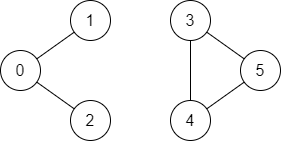【2022-12-19每日一题】1971. 寻找图中是否存在路径[Easy]
2022-12-19
3分钟阅读时长
2022-12-19每日一题:1971. 寻找图中是否存在路径
难度:Easy
标签:深度优先搜索 、 广度优先搜索 、 并查集 、 图
有一个具有 n 个顶点的 双向 图,其中每个顶点标记从 0 到 n - 1(包含 0 和 n - 1)。图中的边用一个二维整数数组 edges 表示,其中 edges[i] = [ui, vi] 表示顶点 ui 和顶点 vi 之间的双向边。 每个顶点对由 最多一条 边连接,并且没有顶点存在与自身相连的边。
请你确定是否存在从顶点 source 开始,到顶点 destination 结束的 有效路径 。
给你数组 edges 和整数 n、source 和 destination,如果从 source 到 destination 存在 有效路径 ,则返回 true,否则返回 false 。
示例 1:

输入:n = 3, edges = [[0,1],[1,2],[2,0]], source = 0, destination = 2 输出:true 解释:存在由顶点 0 到顶点 2 的路径: - 0 → 1 → 2 - 0 → 2
示例 2:

输入:n = 6, edges = [[0,1],[0,2],[3,5],[5,4],[4,3]], source = 0, destination = 5 输出:false 解释:不存在由顶点 0 到顶点 5 的路径.
提示:
1 <= n <= 2 * 1050 <= edges.length <= 2 * 105edges[i].length == 20 <= ui, vi <= n - 1ui != vi0 <= source, destination <= n - 1- 不存在重复边
- 不存在指向顶点自身的边
方法一:DFS
func validPath(n int, edges [][]int, source int, destination int) bool {
if source == destination {
return true
}
conn := make([][]int, n)
for _, e := range edges {
x, y := e[0], e[1]
conn[x] = append(conn[x], y)
conn[y] = append(conn[y], x)
}
vis := make([]bool, n)
var dfs func(int) bool
dfs = func(s int) bool {
if vis[s] {
return false
}
vis[s] = true
for _, x := range conn[s] {
if x == destination {
return true
}
if dfs(x) {
return true
}
}
return false
}
return dfs(source)
}
// 大佬写法
func validPath(n int, edges [][]int, source int, destination int) bool {
vis, conn := make([]bool, n), make([][]int, n)
for _, e := range edges {
x, y := e[0], e[1]
conn[x] = append(conn[x], y)
conn[y] = append(conn[y], x)
}
var dfs func(int) bool
dfs = func(s int) bool {
if s == destination {
return true
}
vis[s] = true
for _, x := range conn[s] {
if !vis[x] && dfs(x) {
return true
}
}
return false
}
return dfs(source)
}
复杂度分析
- 时间复杂度:$O(n+m)$,其中 n 表示图中顶点的数目,m 表示图中边的数目。
- 空间复杂度:$O(n+m)$,其中 n 表示图中顶点的数目,m 表示图中边的数目。
BFS
func validPath(n int, edges [][]int, source int, destination int) bool {
vis, conn := make([]bool, n), make([][]int, n)
for _, e := range edges {
x, y := e[0], e[1]
conn[x] = append(conn[x], y)
conn[y] = append(conn[y], x)
}
q := []int{source}
vis[source] = true
for len(q) > 0 {
i := q[0]
if i == destination {
return true
}
q = q[1:]
for _, j := range conn[i] {
if !vis[j] {
q = append(q, j)
vis[j] = true
}
}
}
return false
}
复杂度分析
- 时间复杂度:$O(n+m)$,其中 n 表示图中顶点的数目,m 表示图中边的数目。
- 空间复杂度:$O(n+m)$,其中 n 表示图中顶点的数目,m 表示图中边的数目。
并查集
// find 递归版本
func validPath(n int, edges [][]int, source int, destination int) bool {
p := make([]int, n)
for i := range p {
p[i] = i
}
var find func(int) int
find = func(x int) int {
if p[x] != x {
p[x] = find(p[x])
}
return p[x]
}
for _, e := range edges {
p[find(e[0])] = find(e[1])
}
return find(source) == find(destination)
}
// find 迭代版本
func validPath(n int, edges [][]int, source int, destination int) bool {
p := make([]int, n)
for i := range p {
p[i] = i
}
find := func(x int) int {
for p[x] != x {
p[x] = p[p[x]]
x = p[x]
}
return x
}
for _, e := range edges {
p[find(e[0])] = find(e[1])
}
return find(source) == find(destination)
}
复杂度分析
时间复杂度:O(n+m×α(m)),其中 n是图中的顶点数,m 是图中边的数目,α 是反阿克曼函数。并查集的初始化需要 O(n)的时间,然后遍历 m 条边并执行 m 次合并操作,最后对 source 和 destination 执行一次查询操作,查询与合并的单次操作时间复杂度是 O(α(m)),因此合并与查询的时间复杂度是 O(m×α(m)),总时间复杂度是 O(n+m×α(m))。
空间复杂度:O(n),其中 n 是图中的顶点数。并查集需要 O(n) 的空间。